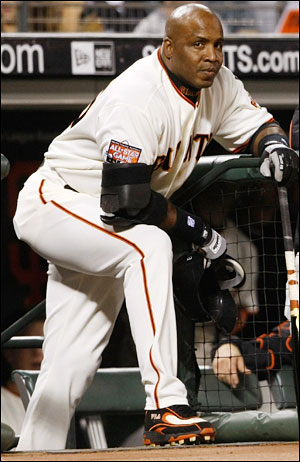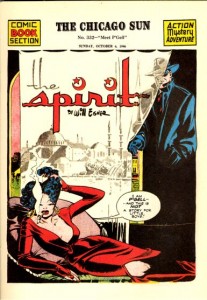Book Review – The Book of Basketball
 The Book of Basketball seemed like the perfect book for me, a natural fit.
The Book of Basketball seemed like the perfect book for me, a natural fit.
But Bill Simmons’ magnum opus, although entertaining and somewhat informative, fell short of my expectations.
You see, like most Canadians, I don’t know a lot about basketball. Sure, I watch maybe a game per week, I know the big name players and I certainly respect their athleticism and the skill necessary to play in the National Basketball Association.
But that level of interest pales in comparison to my obsession with hockey. That’s just the sad truth: In Canada, basketball always plays second fiddle to hockey. From an early age we’re all ingrained with an understanding of hockey that fuels our fascination.
It’s hard for any sport, especially one that runs at roughly the same time as the National Hockey League, to gain any kind of popular traction amongst Canadians.
What it boils down to for me is this: if you gave me a TV with only two channels, one broadcasting the classic 1986 NBA Finals with Magic Johnson’s Los Angeles Lakers facing Larry Bird’s Boston Celtics and the other showing a pre-2004 lockout game between the New Jersey Devils and Minnesota Wild, I’d probably end up watching the hockey.
However, I’m always trying to broaden my horizons, especially when it comes to sports and writing, and so I want to expand my basketball knowledge base.
Further, Simmons has always impressed me as an imaginative writer who can inform and amuse. Anyone who’s read his blog or followed him on Twitter knows he has a deep and abiding passion for basketball, so it seemed like reading his tome would be the perfect way to familiarize myself with the game.
There’s no denying that I learned a lot from Simmons’ 736 page treatise on every imaginable detail of professional basketball. His meticulously researched book does a lot to explain the evolving styles of play as well as the different personalities that have made up the NBA and American Basketball Association.
His lengthy footnotes and parenthetical asides made me laugh out loud and his pop-culture references are always on point. He’s got a gift for keeping sections that would otherwise be deathly boring fun and fresh. Unfortunately, they also add about an extra 100 pages to an already lengthy book.
That’s just one symptom of this book’s fatal flaw: it is poorly edited. Simmons should’ve been reined in to try and keep the book and more manageable length.
Further, a more consistent naming protocol should have been used. Player’s first names, last names and nicknames are used interchangeably from paragraph to paragraph, sometimes sentence to sentence. Although it can lead to some echoes in the writing, sticking to a standard would have lowered the word count - and in a book this big that could end up cutting some pages – and would have made the book more accessible.
This is where the book ultimately failed me.
As a survey of the history and players of professional basketball, the Book of Basketball seemed like the ideal entryway for a novice fan trying to learn about the sport. But it seems as though Simmons never really decided who his target audience was going to be, and so his narrative swings from being explanatory and appropriate for the new fan, to detailed and filled with in jokes only a long-time NBA fan would get.
Writing a book for the sophisticated fan is fine, but it should be advertised as such and be consistent in its level of accessibility. Unfortunately, the Book of Basketball is all over the map in comprehension, making it a frustrating read.
Bill Simmons’ Book of Basketball is funny and smart, but could’ve used a more firm editorial hand to rein in some of the author’s lengthier footnotes and asides to make a slightly more concise book that is accessible for all readers.
Book Review – The Glass Castle by Jeannette Walls
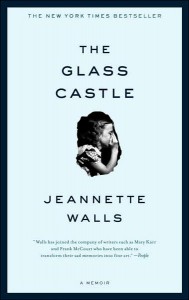 I never thought that I’d enjoy Jeannette Walls’ the Glass Castle, but I was wrong.
I never thought that I’d enjoy Jeannette Walls’ the Glass Castle, but I was wrong.
On the surface, it looked like it was more for stay-at-home moms. It was one of Heather’s Picks at Chapters-Indigo Bookstores and reeked of Oprah’s Book Club. But once I started reading it I appreciated Walls’ writing and was moved by her story.
Like Frank McCourt’s ultra-popular Angela’s Ashes, the Glass Castle is a dark memoir about a dysfunctional family crippled by the father’s alcoholism and the mother’s loose grip on reality.
The Glass Castle also follows a very similar format to Angela’s Ashes with each short chapter detailing an episode from the childhood of the author. More often than not these are horrible snapshots of poverty or struggle as the Walls’ household disintegrates.
These grim anecdotes are broken up by some funny stories from Jeannette’s childhood and the reader is buoyed up by the loyalty of her three siblings as they try to support each other and overcome their parents’ shoddy upbringing.
Walls’ writing is very good and although the subject matter is depressing and unsettling, she wisely injects some humour to create some balance.
What interested me the most was the social dynamics within the Walls household. Jeannette and her three siblings all independently come to the conclusion that their parents are unfit to raise them and that they need to take matters into their own hands.
Writing a compelling memoir is difficult. I’ve read many autobiographies that tell the author’s life story chronologically and from a single perspective. That’s a totally fair and natural way to structure a narrative, especially since an omniscient narrator would be some trick, but it’s obviously also quite limiting.
But Walls – a long-time journalist and former blogger with MSNBC.com – does well to flesh out the “characters” of her family and imply the feelings and motivations of each relative. This adds depth to her story that most autobiographies lack. The way her parents and sibling handles each situation is unquestionably real.
Walls is also a reasonably fair and balanced narrator. Her family might not be thrilled with their personal histories being exposed, but it’d be hard for any member of the Walls clan to say that Jeannette did them a disservice. She lets their actions speak for themselves and rarely puts words in their mouths.
Normally I would dismiss the Glass Castle out of hand. But Walls’ incredible storytelling abilities and the devastating circumstances of her childhood make this memoir a must-read for any fan of literature.
Book Review: the Imperfectionists by Tom Rachman
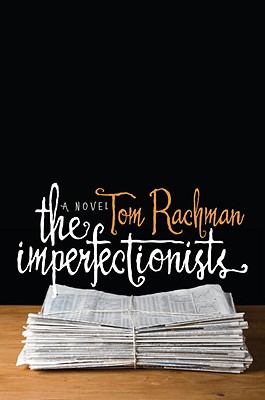 As much as I love reading, it’s rare that a book leaves me breathless. Tom Rachman’s the Imperfectionists does just that, over and over again.
As much as I love reading, it’s rare that a book leaves me breathless. Tom Rachman’s the Imperfectionists does just that, over and over again.
Rachman is a London-born journalist who has worked all over the world and he chose a familiar subject for his debut novel – the newsroom of an English-language paper in Rome.
Each chapter revolves around a different staff member or reader, with many of their stories intersecting and building on previous episodes. At every interval there is a short story about the history of the paper, colouring in some of the background of the main storyline.
It’s a masterful plot structure, deftly done, especially for a first-time novelist. The way the disparate characters and storylines intertwine and relate shows how skilled Rachman is as a storyteller.
The book had been recommended to me by my fiancé, who knew it’s tales of deadline drama in a newsroom would appeal to me, and she was spot on. Although Rachman never stoops as low as cliché or caricature, many of the characters rang true.
All of the characters are sketched out with a deft touch rarely seen in even the best authors, let alone by a first-timer. Rachman’s cast are remarkably realistic and likeable, creating sympathy for the characters and disappointment when things inevitably turn sour for the protagonists.
That’s really my one complaint about the Imperfectionists – it’s unrelentingly depressing. No good deed goes unpunished in Rachman’s world. Characters are craven and selfish. Infidelity is common with everyone ending up alone. Even success comes at a great cost in this world.
Half-way through I was dying for at least one good thing to happen to a character. Some sort of ray of hope, one chance at redemption. Anything! I was desperate for a lifeline, but it never came.
No, Rachman never gives up on his dark outlook, with the final chapter being one of the most heartbreaking.
Despite that, the Imperfectionists is an excellent read that will impress you with its complex structure. Although I was introduced to it because of my occupation as a journalist, I think this book would appeal to anyone. Definitely worth checking out.
Graphic Novel Review: Tom Strong by Alan Moore and Chris Sprouse
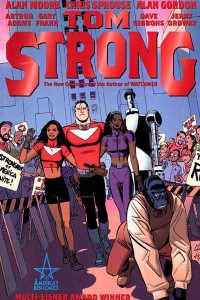 Every medium has its strange little quirks. Odd little rules of the form that have developed and that creators rarely deviate from.
Every medium has its strange little quirks. Odd little rules of the form that have developed and that creators rarely deviate from.
For example, it is rare for a movie to have a plot that unfolds in real time. Television shows are limited in length by half-hour increments, allowing, of course, for commercials. You may see a program that’s 15 minutes long, but never 45 minutes.
It’s theoretically possible to have a show be 20 minutes long or a movie that is in real time, but it’s rarely if ever done in practice.
Comic books are no different. They have their own rules and standards that creators are obliged to follow.
One of the most peculiar things about sequential art as a medium is that it is largely devoted to a single genre – superhero action/adventure.
There are certainly lots of comics that do not involve capes or tights. But the vast majority of the comics produced in this medium prominently feature superheroes.
It wasn’t always this way. In the aftermath of the Second World War, superhero titles began to disappear off the rack. Only Batman, Superman and Wonder Woman survived in any form. Titles like Captain America, Captain Marvel and Green Lantern were replaced by Westerns, Romances and especially horror books.
However, as the Silver Age dawned with Showcase #4 and Fantastic Four #1, superheroes came back in to vogue. DC and Marvel plunged into producing cape and tights stories almost whole hog. Even characters that were of other genres like Nick Fury, Jonah Hex, Mille the Model, Patsy Walker and the Two-Gun Kid were folded into their mainstream continuity.
Since then, the medium and the genre have been inexorably linked. Sure, there are still some comics that do not feature superheroes, but they are few and far between.
It would be like if CBS and NBC’s programming was almost entirely police procedural dramas.
All this serves a lengthy preamble to talk about Alan Moore’s America’s Best Comics, an attempt by the famed author to break free from the superhero genre. He introduced books like Top 10, Promethea and Greyshirt that were departures from the usual comic book fare.
The most prominent work in the ABC line was Tom Strong, an analog of Doc Savage, Tarzan, Tom Swift and other pulp-styled heroes of the early 20th century.
Although still definitely an action-adventure story, Tom Strong is not a crime fighter or vigilante of any sort. His primary interest is science and education. He’s constantly inventing Swiftian devices that, predictably, become useful in his latest adventure. He is a utopianist devoted to improving his world.
Of course, Strong is often beset by villains who want to destroy his hometown of Millennium City or kill him to avenge an earlier defeat. Enemies like Nazi air pirate Ingrid Weiss, technological plague the Modular Man and Strong’s arch-nemesis Paul Saveen plague the hero and his family.
They’re all fun, off-beat characters that can make you laugh while remaining threatening to the safety of Tom Strong and his extended family.
As always, Moore does a fantastic job of developing characters quickly and creating entertaining traps for Strong to unravel, all while maintaining the traditional sense of fun inherent in all pulp fiction.

Chris Sprouse's incredible work on Tom Strong. Tom Strong is conceived as Pneuman the Pneumatic Man watches on.
Chris Sprouse’s artwork shines. It’s crisp, clean and expressive, while being remarkably detailed where required. He’s a master illustrator who can communicate emotions to his readers in a single, textless panel. It’s some of the best artwork I’ve ever seen in a comic.
Sprouse isn’t the only penciler on this series though. Other acclaimed artists like Arthur Adams, Gary Frank, Dave Gibbons and Jerry Ordway lend a hand. Their inclusion in the project was done in a very clever way – they draw all the flashback scenes. Because these looks into Tom Strong’s past are presented as older issues of the series, the different styles aren’t jarring and, if anything, add to the whole piece.
I would recommend Alan Moore’s Tom Strong to anyone who enjoys comics, but especially to those who want a break from the more mainstream and mundane superhero books that clutter shelves at your local shop. He remains one of the few creators in the medium that can shed the cloak of superheroes.
Book Review: King Leary by Paul Quarrington
 Paul Quarrington’s novel King Leary is a funny, insightful look at the world of professional hockey in the early 20th century that would be enjoyable for fans of the sport or someone looking for a quick read.
Paul Quarrington’s novel King Leary is a funny, insightful look at the world of professional hockey in the early 20th century that would be enjoyable for fans of the sport or someone looking for a quick read.
Published in 1987, Quarrington’s tale won the Stephen Leacock Medal for Humour in 1988 and was shortlisted for that year’s Trillium Book Award.
It regained prominence in 2008 when the Rheostatics' Dave Bidini championed it for the CBC’s Canada Reads program. Bidini’s campaign saw King Leary become a best-seller and win the award 10 years after it first appeared on book shelves.
Narrated by Percival “King” Leary, one of the greatest professional hockey players to ever live, the story follows him as he travels from his retirement home to Toronto to shoot a ginger ale commercial with Duane Killebrew, the National Hockey League’s current scoring champion.
During the trip Leary recalls how he learned to play while at reformatory school and his complicated friendships with Clay Bors Clinton and Manfred Ozikean. He also touches on the fractious relationships with his sons Clarence and Clifford, as well as his wife Chloe and her sister Jane.
For the reader less familiar with hockey, King Leary will entertain with its amusing anecdotes and poignant moments. Quarrington is a masterful storyteller, subtly hinting at darkness that seeps into an otherwise humorous narrative.
Literary minded hockey fans will appreciate his nods to the major figures in the game’s lore. Quarrington works in several real-life legends of the game like Georges Vezina and Eddie Shore.
At the same time, many of the characters are clearly based off other historical figures. Clinton is a mix of Conn Smythe and Harold Ballard. Killebrew is clearly meant to be Wayne Gretzky, with a passing reference to a player “down in Pittsburgh” that hints at Mario Lemieux.
Leary himself resembles a number of players, especially Toronto Maple Leafs great Francis Michael “King” Clancy.
The one disappointing aspect of the book is that although Quarrington is deft at the characterization of all of the main characters, supporting characters like Leary’s nurse Iain or the advertising executive Claire are painted with an extraordinarily broad brush. Their dialogue seems forced and unnecessarily flamboyant to the point that their characters are a distraction that clutters the page.
Aside from that, King Leary is a fine story. A quick reader could blow through Quarrington’s work in an afternoon, and would enjoy it regardless of their attachment to Canada’s favourite game. Definitely worth picking up.
Book Review: Hitman by Bret Hart
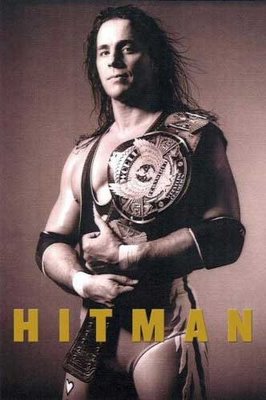 I received Bret “the Hitman” Hart’s autobiography as a Christmas present two years ago, and put it on my ever-growing reading list. Well, its turn finally came around and I’m glad it did – it’s a fascinating, although somewhat disturbing, read.
I received Bret “the Hitman” Hart’s autobiography as a Christmas present two years ago, and put it on my ever-growing reading list. Well, its turn finally came around and I’m glad it did – it’s a fascinating, although somewhat disturbing, read.
Hart has had one of the most successful careers in professional wrestling history, starting in Calgary with his father’s Stampede Wrestling and rising through the ranks of the business to win the top titles in both the World Wrestling Federation and the rival World Championship Wrestling.
His memoir is very family-centric, looking at his relationship with his parents Helen and Stu, his 11 siblings, their spouses and his wife Julie. He also discusses in great detail the end of his tenure in the WWF, when promoter Vince McMahon and some of Hart’s co-workers conspired to strip Hart of the World Championship belt before leaving for WCW.
One of the last of the truly old school wrestlers, Hart always maintained the professional wrestling code of honour –kayfabe – that the fact that the matches are pre-determined never be revealed. When he was an active wrestler, he and his brother Owen did not speak to each other in public for years because in the storylines they were enemies.
However, the Harts broke kayfabe for the filming of the documentary Wrestling with Shadows, which coincidentally covered the abrupt end of his career with the WWF.
This event, known to wrestling fans as “the Montreal Screwjob” is the climax of the book’s third act, bringing to a head simmering professional and sibling rivalries that sink Hart into a deep depression. Ultimately, it leads to a life-changing stroke that paralyzes the athletically gifted Calgarian.
Hart’s writing is striking not just because of the content, but also the tone. His family settles most of its squabbles through violence. His fellow wrestlers indulge in performance enhancing and recreational drugs at an alarming rate. Hart writes candidly about his many extra-marital affairs that wreck havoc on his already tempestuous marriage. Somehow, Hart has a nonchalant tone about the dysfunction that surrounds him throughout the book.
Even then, Bret seems dowdy compared to some of his brothers like Smith, who has fathered countless children out of wedlock, or Dean, whose drug use exacerbates his Bright’s Disease, eventually leading to kidney failure.
The tragic death of Owen, the youngest member of the Hart clan, is the final straw as the family implodes. The family becomes divided as various siblings turn on each other, trying to publicly embarrass their rivals or force them into bankruptcy.
As the Hart’s are at war, Bret’s wrestling family also turns on him. In particular, Vince McMahon, Shawn Michaels and Hunter Hearst Helmsley align against him to oust him from his position as the face of the WWF.
It’s an emotional, dark read that will shock the reader with its graphic descriptions of Hart’s lonely, violent and nomadic life as a professional wrestler.
I’d recommend Bret Hart’s memoir to anyone, professional wrestling fan or not, for its candid look at what amounts to office politics as well as the tragic undoing of the Hart family. There are lessons to be learned from Hart’s life that go beyond how to take a chair to the head or how to make yourself bleed.
Graphic Novel Review: The Best of the Spirit by Will Eisner
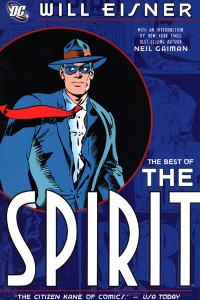 Amongst comic book fans, Will Eisner’s the Spirit is legendary. It’s the foundation on which modern sequential art has been built. Indeed, on the cover of the Best of the Spirit, USA Today praised it as “The Citizen Kane of Comics.”
Amongst comic book fans, Will Eisner’s the Spirit is legendary. It’s the foundation on which modern sequential art has been built. Indeed, on the cover of the Best of the Spirit, USA Today praised it as “The Citizen Kane of Comics.”
This, of course, made me pretty sceptical. After all, one of my favourite pet theories is Citizen Kane Syndrome, which states that influential classics lose their lustre because what made them shine is now cliché. I shouldn’t have been concerned though – the Spirit easily lives up to all the hype.
The Spirit was a widely syndicated adventure comic that appeared as an insert in Sunday newspapers across the United States starting with the aptly named "Origin of the Spirit" published on June 2, 1940. The Spirit was originally Denny Colt, a criminologist killed while on a case. Reincarnated as the apparently immortal Spirit, he sought justice around the world. The original run lasted 12 years, and changed the way comic book writers and artists worked.
Eisner is often cited as an artistic genius who revolutionized pacing and layout. All of that skill is brought to life on the pages of the Best of the Spirit. His characters are cartoonish, but remain incredibly emotive. Characters that appear for only a panel or two are instantly sympathetic. And if you want to see just how groundbreaking his design is, please check out the picture on the right.
I’ve often heard it said that Eisner was not afraid to spill ink all over the page and make his work incredibly dark. This is true, he’s not afraid of filling negative space with ink. However, it’s his colouring that was striking. It is incredibly bright and vibrant – bright yellows, oranges and greens pop in comparison to the black ink.
Also, when the scene calls for it, Eisner will leave more than half a page blank with some lettering and one or two characters. His reputation for dark, moody work belied a surprisingly diverse and colourful style.
What really impressed me though, was the quality of his writing.
The stories are short – seven pages each – but cram in an entire tale that manages to include character development, action and resolution in one neat package. This is a far cry from today’s decompressed epics where it takes nearly 100 pages for anything of substance to happen.
I would love to see a monthly Batman or Spider-Man book where there are two or three of these quick stories. They could be one-and-dones where the hero handles a case in the span of one night. I think it’d be a great contrast to the longer, more involved plotlines being used today. It would also make a great jumping on point for new fans.
There are some small drawbacks to the Spirit, of course. The inadvertent racism of the Spirit strips can make the reader uncomfortable. Aside from a few brief glimpses, the highly offensive Ebony White wasn’t included in this collection. But there is still a brief appearance of an Italian landlady, Mrs. Pizza, who says things like “No sorr... She’sa keep d’apart-ement joosa like dis...” Yikes. Eisner had to create characters in shorthand to save space, and too often that means stereotypes.
What’s most impressive about this book is how well it holds up. These stories were originally published between 1940 and 1950, but they’re still quick and fun. I’m definitely going to try and pick up more editions of the Spirit to add to my collection.
The Best of the Spirit was a pleasant surprise that confounded my expectations and is definitely worth checking out if you're not familiar with Will Eisner's work.
Book Review: Gretzky’s Tears by Stephen Brunt
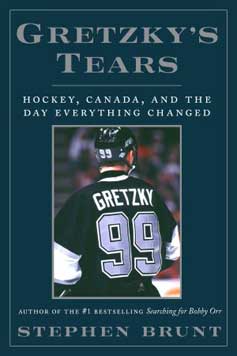 Gretzky’s Tears is the latest book by the Globe and Mail’s Stephen Brunt. It examines the controversial trade of Wayne Gretzky from the Oilers to the Los Angeles Kings, almost bringing an end to Edmonton’s Stanley Cup dynasty and launching the National Hockey League’s sputtering Sunbelt Expansion.
Gretzky’s Tears is the latest book by the Globe and Mail’s Stephen Brunt. It examines the controversial trade of Wayne Gretzky from the Oilers to the Los Angeles Kings, almost bringing an end to Edmonton’s Stanley Cup dynasty and launching the National Hockey League’s sputtering Sunbelt Expansion.
Brunt is one of Canada’s foremost sports journalists, and one of the best “big picture” writers in the newspaper business today. Unfortunately, Gretzky’s Tears does not meet Brunt’s usually high standards, particularly in contrast to his own body of work and other media on the subject.
The closest comparison is Brunt’s previous book, Searching for Bobby Orr, which I reviewed on my old blog . Indeed, in the Acknowledgements section of Gretzky’s Tears Brunt says that it was intended as a sequel to Searching.
Both books spotlight the greatest hockey player of their generation, both address the theme of innocence lost and both subjects shy away from the limelight. Orr was always intensely private and Gretzky is big on controlling his own public image.
As a result, Brunt was unable to interview either player for his books. Instead, he focuses on interviewing the people around Gretzky and Orr, painting a picture of the circumstances and personalities surrounding these prominent Canadian figures.
It was a very effective method in Searching for Bobby Orr, but falls flat in Gretzky’s Tears.
The difference is that Orr’s entourage has maintained an omerta-like silence around the former Boston Bruin. Even former business associates like Alan Eagleson and Harry Sinden, both of whom have fallen out with Orr, did not participate in Brunt’s research for Searching.
However, in Gretzky’s Tears, two of the principals in the trade, former Oilers owner Peter Pocklington and former Kings owner Bruce McNall, submitted to extensive interviews. The result comes across as a rather jaundiced account of the deal. Pocklington and McNall (and to a lesser extent former Edmonton General Manager Glen Sather) all get to say their piece, wheras Brunt, and therefore the reader, are left to guess at Gretzky’s state of mind before and after the move.
This would be fine if Gretzky’s Tears was created in a vacuum.
Unfortunately for Brunt, Pocklington wrote (with the help of Terry McConnell and J’Lyn Nye) a book of his own called I’d Trade Him Again that includes a forward by the Great One.
Worse yet, ESPN’s 30-for-30 documentary Kings Ransom also looks at the trade and filmmaker Peter Berg spoke extensively with Gretzky.
A smaller problem with the book is that it seems as though the editors backed off of Brunt’s copy. This might be because of the success of Searching for Bobby Orr, but Gretzky’s Tears suffers without a firm guiding hand.
The first chapter of Gretzky’s Tears is a ponderous exploration of loss of innocence that could have been cut completely. Further, Brunt has, for whatever reason, begun to copy sentences from one chapter to the next almost verbatim.
For example, towards the end of the book Brunt discusses Canada’s Olympic gold medal in 2002 and the rousing speech Greztky made at a press conference early in the games.
“[Gretzky] suggested that Canada was all alone, that the rest of Planet Hockey wanted it to fail, that it was us against the world. Standing in the room listening to him that day, it was difficult to tell how much was honest emotion, how much was a contrived attempt to inspire his team.” (p. 245)
Interesting commentary, except that just 45 pages earlier Brunt had described the same incident:
“Gretzky without prompting launched into a tirade – spontaneous or contrived – about how the whole hockey world wanted Canada to lose, it became a natural call to arms for both the country and the players.” (p. 200)
I only used excerpts, but aside from sentence structure the passages are almost identical.
It’s not an isolated incident either. There are several paragraphs throughout the book that repeat information and use similar phrasing. It’s a distracting habit and one that Brunt or his editor should have picked up on.
And that is the most disappointing thing about this book.
Stephen Brunt is an excellent writer who, in my opinion, is one of the best sports columnists in Canada. Searching for Bobby Orr was thoroughly researched and did a wonderful job of explaining the magic of Orr. On the other hand, Gretzky’s Tears is a flawed book that suffers by comparison to Brunt’s earlier work and the work of others.
By any other author this would be a solid book, but Brunt is a victim of his own success.
Graphic Novel Review – Satchel Paige: Striking Out Jim Crow by James Sturm and Rich Tommaso
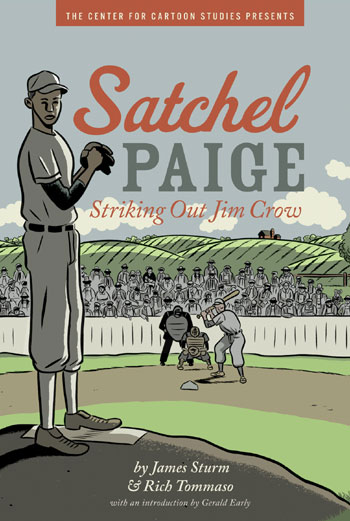 I was wandering through my local library when I saw the name “Satchel Paige” on the spine of a graphic novel and was immediately intrigued. The legendary pitcher has always interested me and I wanted to learn more. Even though it was written for young adults I borrowed it, figuring it was worth a look.
I was wandering through my local library when I saw the name “Satchel Paige” on the spine of a graphic novel and was immediately intrigued. The legendary pitcher has always interested me and I wanted to learn more. Even though it was written for young adults I borrowed it, figuring it was worth a look.
It turns out that I’d picked a fantastic piece of work by independent comic stars James Sturm and Rich Tommaso. In their hands the plight of African American sharecroppers in the Jim Crow south and the magic of Satchel Paige comes to life.
If you’re not familiar with Paige, then you’re missing out on a nearly mythical figure in American history.
Argued by some as the greatest pitcher of all time, Paige claimed that he had pitched in 2,500 games and won 80% of them. Of course, his claims can’t be verified since, as an African American, he couldn’t play in the major leagues until Jackie Robinson had broken the colour barriers, and Paige was in his 40s. Baseball historians have since confirmed that he won at least 291 games between various leagues across the United States and Carribbean.
Tomasso uses sepia tones picked out with heavy black ink to render the tale of Emmet Wilson, his son Emmet Jr. and, of course, the legendary Paige. His style is reminiscent of children’s illustrators of the 40s and 50s like H.A. Rey of Curious George fame or Ezra Jack Keats’ Snowy Day.
Relying on a straight forward six panel frame for most of his pages, Tomasso’s art is well-paced. In particular, the baseball games are very exciting and are a nice mix of extreme close-ups, expansive double-wide panels and reaction shots. (Click here to read the first ten pages online)
At first, Tommaso’s plain, two-toned artwork seems too simple for the subject matter. However, he handles graphic images like the lynching of a sharecropper with great sensitivity. Tomasso deservedly won an Eisner Award in 2008 for his work on the book.
Sturm’s script draws the reader in and creates a real sense of tension, particularly surrounding the menacing Jennings twins who seem capable of anything.
He also does a good job of differentiating between the latent racism of Southern society represented by segregated baseball fields or the paternalistic Mr. Jennings and the blatant hatred of his twin boys who engage in violent hate crimes.
Most impressively, Sturm handles the enigmatic Paige with a rare touch that maintains his mystique while making him into an early champion of racial toleration. The penultimate scene where Paige faces down the bigotry of the Jennings brothers is a slow, simmering burn that the reader can savour.
The Center for Cartoon Studies commissioned this book, and they deserve full credit for putting together a wonderful package that includes online resources like samples of Tomasso’s draft work and other tools for teachers. Of course, they also put the Sturm-Tomasso tandem together which is what makes the book great.
Although geared towards adolescents, Satchel Paige: Striking Out Jim Crow is an enjoyable, light read that doesn’t shy away from some tough subjects. Sturm and Tommaso are deft storytellers that express a myriad of emotions with minimal words and art.

